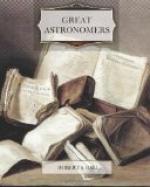Airy’s writings were most voluminous, and no fewer than forty-eight memoirs by him are mentioned in the “Catalogue of Scientific Memoirs,” published by the Royal Society up to the year 1873, and this only included ten years out of an entire life of most extraordinary activity. Many other subjects besides those of a purely scientific character from time to time engaged his attention. He wrote, for instance, a very interesting treatise on the Roman invasion of Britain, especially with a view of determining the port from which Caesar set forth from Gaul, and the point at which he landed on the British coast. Airy was doubtless led to this investigation by his study of the tidal phenomena in the Straits of Dover. Perhaps the Astronomer Royal is best known to the general reading public by his excellent lectures on astronomy, delivered at the Ipswich Museum in 1848. This book has passed through many editions, and it gives a most admirable account of the manner in which the fundamental problems in astronomy have to be attacked.
As years rolled by almost every honour and distinction that could be conferred upon a scientific man was awarded to Sir George Airy. He was, indeed, the recipient of other honours not often awarded for scientific distinction. Among these we may mention that in 1875 he received the freedom of the City of London, “as a recognition of his indefatigable labours in astronomy, and of his eminent services in the advancement of practical science, whereby he has so materially benefited the cause of commerce and civilisation.”




